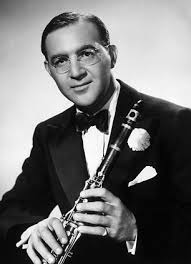From a poor Jewish family, Goodman began clarinet studies at 11; a year or so later he appeared on stage with local bandleader Benny Meroff. He was first noticed by the wider world as a member of the Ben Pollack orchestra, making his debut recordings with them in 1926. His solo style at this stae was a combination of Jummy Noone, Ted Lewis, and Leon Rappolo. Leaving Pollack in 1929, Goodman became a successful freelancer in New York. By 1934 Goodman wanted his own band: landing a spot on a national NBC radio broadcast, he played New York’s hotels and music rooms and waited. Sent out on a tour to the Californian coast, Goodman and his band played in a “hot” smooth-swinging style which left their audiences bewildered until they reached the Palomar Ballroom in Los Angeles. Here the band got an overwhelming response from the young audience, many of whom were familiar with the band from the radio broadcast, which was late-night in New York but mid-evening in California due to the time difference. Within months Goodman was national craze and the Swing Era was officially launched. Goodman was dubbed the “King of Swing”: his reign lasted almost to the end of the 1930s, long enough at least to score a triumph at Carnegie Hall in early 1938, the first jazz artist to present a complete evening’s entertainment in that august setting. Goodman’s hankering after the approval of “serious music” performers led to his performing and recording clarinet music by Mozart and commissioning Bela Bartok to write Contrasts for clarinet, violin and piano. However, more substantial musical progress was made through the vehicle of Goodman’s small groups, inaugurated in 1935 and utilizing during the 1930s a racially mixed personnel (virtually unheard of at that time) of Teddy Wilson, Lionel Hampton, and Gene Krupa. This was expanded during the early 1940s to include the guitar genius Charlie Christian, trumpeter Cootie Williams, and saxophonist Georgie Auld. By that time Goodman had been overtaken in popularity by such bands as those of Glenn Miller, Artie Shaw, Charlie Barnet, and Tommy Dorsey, although in 1942 he enjoyed a million-seller with “Why Don’t You Do Right?” featuring a newcomer called Peggy Lee. After WWII Goodman started his policy of running a big band only for specific periods. By this time he was suffering acute pain from chronic back problems, and this physical handicap did much to dictate the shape of his subsequent career. In 1955 he was the subject of a Hollywood biopic, leading his own band in the making of the soundtrack; later in the decade he made US State Department-sponsored tours of Europe and the Far East: this proved to be the prelude for the much-ballyhooed Goodman visit to Russia in 1962. Goodman worked when it suited him during the 1970s and early 1980s; he combined excitingly with George Benson for a small-group workout on US TV in 1975, but otherwise paced himself carefully. Goodman’s unwillingness to incorporate later jazz developments relegated him to the jazz backwaters during his later career, but the exemplary standards he set remain a golden and instructive legacy for those who have followed. musical selections
0 Comments
Leave a Reply. |
Jazz LegendsA blog on the great legends in Jazz. Information via "The Encyclopedia of Jazz and Blues". Archives
December 2017
Categories |

 RSS Feed
RSS Feed

